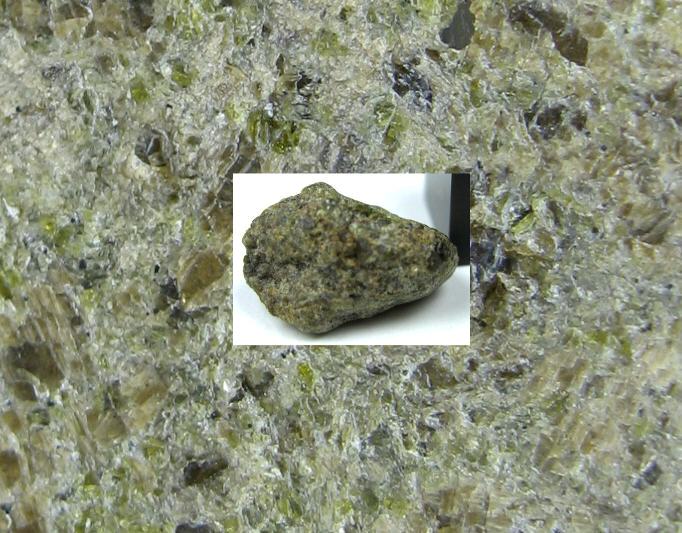NWA 6704
AchondriteAn achondrite is a type of stony meteorite whose precursor was of chondritic origin and experienced metamorphic and igneous processes. They have a planetary or differentiated asteroidal origin where the chondritic parent body reached a sufficient size that through heating due to radioactive decay of 26Al (aluminum isotope) and gravitational Click on Term to Read More, ungroupedModifying term used to describe meteorites that are mineralogically and/or chemically unique and defy classification into the group or sub-group they most closely resemble. Some examples include Ungrouped Achondrite (achondrite-ung), Ungrouped Chondrite (chondrite-ung), Ungrouped Iron (iron-ung), and Ungrouped Carbonaceous (C-ung). Click on Term to Read More
carbonaceous chondrite-related
Found 2010 in Algeria
no coordinates recorded At least forty-two conjoint stone meteoriteWork in progress. A solid natural object reaching a planet’s surface from interplanetary space. Solid portion of a meteoroid that survives its fall to Earth, or some other body. Meteorites are classified as stony meteorites, iron meteorites, and stony-iron meteorites. These groups are further divided according to their mineralogy and Click on Term to Read More fragments, mostly devoid of fusion crustMelted exterior of a meteorite that forms when it passes through Earth’s atmosphere. Friction with the air will raise a meteorite’s surface temperature upwards of 4800 K (8180 °F) and will melt (ablate) the surface minerals and flow backwards over the surface as shown in the Lafayette meteorite photograph below. Click on Term to Read More, were found in Algeria in 2010. They were subsequently purchased by G. Hupé in February 2011 during the Tucson Gem and MineralInorganic substance that is (1) naturally occurring (but does not have a biologic or man-made origin) and formed by physical (not biological) forces with a (2) defined chemical composition of limited variation, has a (3) distinctive set of of physical properties including being a solid, and has a (4) homogeneous Click on Term to Read More Show. Associated fragments were tracked down and acquired from various Moroccan dealers by G. Hupé over the succeeding four months. The total combined weight of these paired fragments was 8,387 g. An additional 5,100 g of fragments, designated NWA 6693, were acquired in March 2011 by E. Thompson and are considered likely paired with NWA 6704. One other group of paired stones previously obtained by G. Fujihara in January 2011 received a separate designation as NWA 6926. A portion of both NWA 6704 and NWA 6926 were submitted for analysis and classification to the University of Washington in Seattle (A. Irving and S. Kuehner), while a portion of NWA 6693 was submitted to the University of California in Los Angeles (P. Warren).
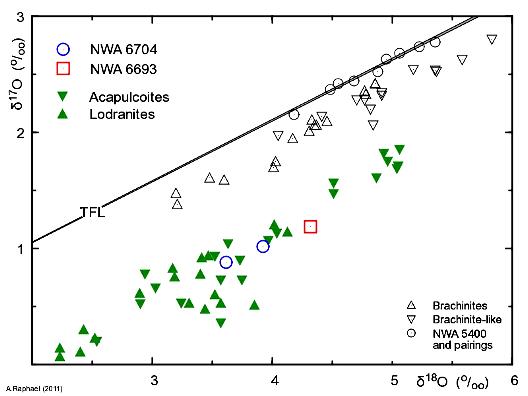
Northwest Africa 6704 — Oxygen isotopes (R. Tanaka, OkaU): replicate analyses by laser-fluorination produced δ17O = 1.015‰, 0.880‰; δ18O = 3.922‰, 3.613‰; Δ17O = -1.048‰, -1.020‰
Northwest Africa 6693 — Oxygen isotopes (B-G. Choi and I. Ahn, Seoul-NU): replicate analyses by laser-fluorination produced δ17O = 1.19‰; δ18O = 4.32‰; Δ17O = -1.08‰
Additional constraints on the origin of this meteorite were established through studies of the Cr-isotopic systematics (Sanborn et al., 2013). The resulting ε54Cr value of +1.69 (±0.07) resolves NWA 6704 from the acapulcoite–lodranite clan (ε54Cr = –0.75; Göpel and Birck, 2010); discrimination between these groups had not been attained through the use of O-isotopic values alone. Continued efforts to better resolve the relationship that exists among the numerous anomalous meteorites has been ongoing (e.g., Bunch et al., 2005, [#2308]; Floss et al., 2005, [MAPS vol. 40, #3]; Irving et al., 2014 [#2465]; Sanborn et al., 2014 [#2032]). As provided in the Sanborn et al. (2014) abstract, a coupled Δ17O vs. ε54Cr diagram is one of the best diagnostic tools for determining genetic relationships among meteorites. The diagrams below include the paired stones NWA 6704 and 6693, and it is apparent that they plot within the CR chondriteClass named for the Renazzo meteorite that fell in Italy in 1824, are similar to CMs in that they contain hydrous silicates, traces of water, and magnetite. The main difference is that CRs contain Ni-Fe metal and Fe sulfide that occurs in the black matrix and in the large chondrules Click on Term to Read More field.
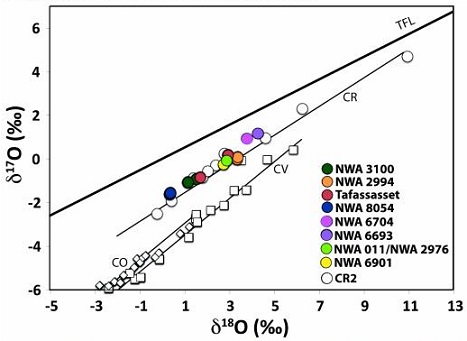
Diagram credit: Sanborn et al., 45th LPSC, #2032 (2014) 17O vs. ε54Cr and ε50Ti for CR Carbonaceous Achondrites
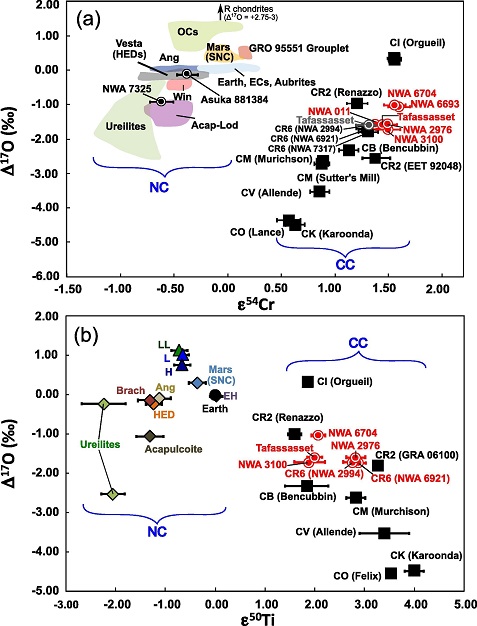
click on image for a magnified view Diagrams credit: Sanborn et al., GCA, vol. 245, pp. 577–596 (2019)
‘Carbonaceous Achondrites Northwest Africa 6704/6693: Milestones for Early Solar SystemThe Sun and set of objects orbiting around it including planets and their moons and rings, asteroids, comets, and meteoroids. Chronology and Genealogy’
(https://doi.org/10.1016/j.gca.2018.10.004) However, a plot of Δ17O vs. olivine Mg# (Mg/[Mg+Fe]) resolves the NWA 6704 pairing group from other meteorite groups as well as ungrouped meteorites with similar O-isotopic compositions, as it displays a significantly more ferroan composition (Warren et al., 2013). Further resolution of the parental source group for NWA 6704 was obtained by Hibiya et al. (2017, 2018) through a titanium isotopeOne of two or more atoms with the same atomic number (Z), but different mass (A). For example, hydrogen has three isotopes: 1H, 2H (deuterium), and 3H (tritium). Different isotopes of a given element have different numbers of neutrons in the nucleus. Click on Term to Read More analysis. It is demonstrated on both Δ17O vs. ε50Ti and ε54Cr vs. ε50Ti coupled diagrams that the meteorite plots within the field for carbonaceous chondritesChondrites are the most common meteorites accounting for ~84% of falls. Chondrites are comprised mostly of Fe- and Mg-bearing silicate minerals (found in both chondrules and fine grained matrix), reduced Fe/Ni metal (found in various states like large blebs, small grains and/or even chondrule rims), and various refractory inclusions (such Click on Term to Read More (see diagrams below). Based on the results of their petrologic, geochemical, and isotopic analyses of NWA 6704, Hibiya et al. (2017, 2018) concluded that an undifferentiated asteroid experienced an impact-generated melting event followed by rapid cooling. Presumably, subsequent burial beneath an ejectaFractured and/or molten rocky debris thrown out of a crater during a meteorite impact event, or, alternatively, material, including ash, lapilli, and bombs, erupted from a volcano. Click on Term to Read More blanket ushered an extended period of slow cooling. ε50Ti vs. 17O and ε54Cr for NWA 6704
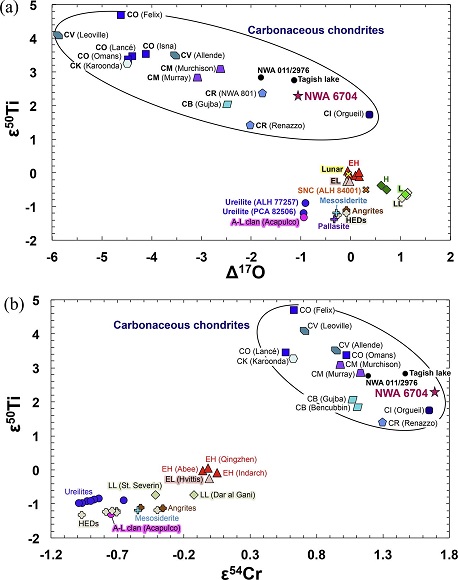
click on image for a magnified view Diagram credit: Hibiya et al., GCA, vol. 245, pp. 597–627 (2019)
‘The origin of the unique achondrite Northwest Africa 6704: Constraints from petrologyScience dealing with the origin, history, occurrence, chemical composition, structure and classification of rocks. Click on Term to Read More, chemistry and Re–Os, O and Ti isotope systematics’
(https://doi.org/10.1016/j.gca.2018.04.031) An Ar–Ar and noble gasElement occurring in the right-most column of the periodic table; also called "inert" gases. In these gases, the outer electron shell is completely filled, making them very unreactive. Click on Term to Read More study was conducted by Fernandes et al. (2013) to constrain the petrologic history and to determine the CRE age of this meteorite. The oldest possible crystallizationPhysical or chemical process or action that results in the formation of regularly-shaped, -sized, and -patterned solid forms known as crystals. Click on Term to Read More age was determined to be 4.56 (±0.29) b.y., or 4–5 m.y. after CAIsSub-millimeter to centimeter-sized amorphous objects found typically in carbonaceous chondrites and ranging in color from white to greyish white and even light pink. CAIs have occasionally been found in ordinary chondrites, such as the L3.00 chondrite, NWA 8276 (Sara Russell, 2016). CAIs are also known as refractory inclusions since they Click on Term to Read More. This is in agreement with the U–Pb age of 4.56280 (±0.00046) b.y. determined by Iizuka et al. (2013), and the most precise and accurate age of 4.56238 (±0.00049) b.y. determined by P. Koefoed (2017). A refined Pb–Pb isochron age of 4.56278 (±0.00018) b.y. was calculated by combining data obtained from both the Australian National University and UC Davis (Huyskens et al. (2017). In a subsequent investigation, Amelin et al. (2019) employed the 238U/235U value directly measured for NWA 6704 of 137.7784 to calculate the most precise and accurate Pb–Pb isochron age of 4.56276 (+0.00022/-0.00030) b.y. In a similar manner, the best age estimate for NWA 6693 was determined to be 4.56263 (+0.00029/-0.00021) b.y. Other isotopic chronometers (e.g., Al–Mg, Mn–Cr [Sanborn et al., 2019], Rb–Sr, Re–Os) give ages that are consistent with the Pb–Pb age and attest to rapid cooling, crystallization, and isotopic closure. Based on initial Sr chronometry data, Amelin et al. (2019) determined that accretionAccumulation of smaller objects into progressively larger bodies in the solar nebula leading to the eventual formation of asteroids, planetesimals and planets. The earliest accretion of the smallest particles was due to Van der Waals and electromagnetic forces. Further accretion continued by relatively low-velocity collisions of smaller bodies in the Click on Term to Read More of the NWA 6693/6704 parent body occurred within 3.6 m.y. of the formation of CAIs. The occurrence of an impact-resetting event prior to complete cooling of the planetesimal is indicated by the loss of fluid from micro-inclusion bubble trains present in orthopyroxene crystals. This event may be related to a resetting event that occurred 4.199 (±0.032) b.y. ago as revealed by Amelin et al. (2018) through Ar–Ar chronometry. In addition, they provided further evidence of another thermal event that occurred ≤2.12 b.y. ago. The CRE age was calculated based on Ne and Ar systematics to be 30 (±3) m.y. (Fernandes et al., 2013). Furthermore, the pre-atmospheric size of the meteoroidSmall rocky or metallic object in orbit around the Sun (or another star). was calculated to have been at least 100 cm in diameter. Further studies have been conducted by Sanborn et al. (2018) of new anomalous ungrouped meteorites recovered in Northwest Africa. Utilizing a coupled Δ17O vs. ε54Cr diagram, they demonstrated that NWA 6704 and pairings, NWA 011 and pairings, and NWA 6962/7680 all plot within the CR/CH carbonaceous chondriteCarbonaceous chondrites represent the most primitive rock samples of our solar system. This rare (less than 5% of all meteorite falls) class of meteorites are a time capsule from the earliest days in the formation of our solar system. They are divided into the following compositional groups that, other than Click on Term to Read More field represented by CR2 Renazzo and CH3 NWA 2210, which suggests a possible genetic linkage among them (see diagram below). Chromium vs. Oxygen-isotope Plot
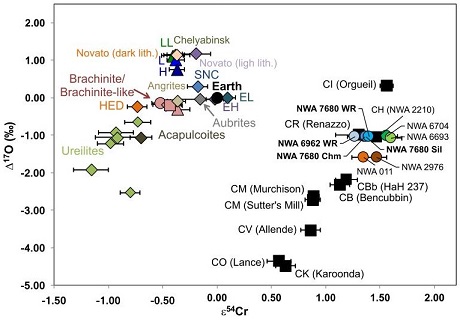
click on image for a magnified view Diagram credit: Sanborn et al., 49th LPSC, #2296 (2018) Sanborn et al. (2018) also determined that the absolute Mn–Cr age (anchored to D’Orbigny) calculated for NWA 6962/7680 (4.56376 [±0.00176] b.y.) is concordant with the ages calculated for both 6704/6693 (Mn–Cr age from Sanborn et al., 2019: 4.56217 [±0.00076] b.y.) and NWA 011/2400/2976 (U–Pb age from Bouvier et al., 2011: 4.56289 [±0.00059] b.y.). It has been proposed by many investigators that a large (~400 km diameter) differentiated CR parent body formed in the early history of the Solar SystemDefinable part of the universe that can be open, closed, or isolated. An open system exchanges both matter and energy with its surroundings. A closed system can only exchange energy with its surroundings; it has walls through which heat can pass. An isolated system cannot exchange energy or matter with and subsequently experienced a collisional disruption. For more information pertaining to this scenario, see the LPSC abstract ”Primitive’ and igneous achondrites related to the large and differentiated CR parent body’ by Bunch et al. (2005), the MetSoc abstract ‘Tafassasset and Primitive Achondrites: Records of Planetary Differentiation’ by Nehru et al. (2014), and the LPSC abstract ‘Collisional Disruption of a Layered, Differentiated CR Parent Body Containing Metamorphic and Igneous Lithologies Overlain by a Chondrite Veneer’ by Irving et al. (2014). The reflectance spectra of NWA 6704 was acquired and compared to that of known asteroid groups (Le Corre et al., 2014). The analysis of a large-sized sample was comparable to spectra from the S(VI) asteroid group, which is thought to represent formation as a partial melt residue (e.g., winonaites). The spectra of a smaller, grain-sized sample plotted between the S(V) and S(VI) asteroid fields, the former thought to represent formation as a metamorphosed H chondriteOrdinary chondrites with a high content of free Ni-Fe metal (15-19 vol. %) and attracted easily to a magnet. Their main minerals are olivine (Fa16-20) and the orthopyroxene bronzite (Fs14.5-18.5), earning them their older name of bronzite chondrites. Chondrules average ~0.3 mm in diameter. Comparison of the reflectance spectra of Click on Term to Read More or a primitive achondriteAchondrite with an almost chondritic composition with age similar to the primordial chondrites. These should be better classified as "metachondrites". (e.g., acapulcoitesPrimitive achondrite that belongs to a small group named after the Acapulco meteorite that was observed to fall in Mexico in 1976. Acapulcoites are made mostly of fine-grained olivine (Fo3-14), orthopyroxene(En86-97), Ca-rich pyroxene (En51Wo44), plagioclase (An12-31), Ni-Fe metal, and troilite. They are transitional between primordial chondritic matter and more differentiated Click on Term to Read More/lodranites). However, direct spectral comparisons of NWA 6704 to known asteroids only produced a relatively close match to V-type asteroids (e.g., VestaThird largest and fourth brightest asteroid; it was discovered in 1807 by Heinrich Olbers and named for the ancient Roman goddess of the hearth. 4 Vesta has a basaltic surface composition and an average density not much less than that of Mars. Evidently lava once flowed here indicating that the). Moreover, direct spectral comparisons of NWA 6704 to HED suite meteorites demonstrated a close similarity to the basaltic and cumulate eucritesMost common type of achondrite meteorite and a member of the HED group. Eucrites are basalts composed primarily of pigeonite and anorthite (An60-98). Eucrites have been placed into three subgroups based on mineralogical and chemical differences. • Non-cumulate eucrites represent the upper crust that solidified on a magma ocean after Click on Term to Read More as well. A separate 940 g stone designated NWA 10132 was found at a location different from the NWA 6704 pairing group, but it has a similar mineralogy, an almost identical O-isotopic composition, and a matching U–Pb age (Irving et al., 2015; Koefoed et al., 2015). Based on these facts, NWA 10132 is thought to be a possible genetic relative, likely co-magmatic and/or launch paired. Consistent with this hypothesis, Y. Amelin (2017) determined that the Rb–Sr data for NWA 10132, NWA 6693, and NWA 6704 are similar and establish an isochron age of 4.543 (±0.035) b.y. In addition, the ε54Cr value for NWA 10132 determined by Sanborn et al. (2018) matches that of the NWA 6704 pairing group, and they calculated an age for NWA 10132 based on Mn–Cr systematics anchored to D’Orbigny of 4.56276 (±0.00041) b.y., as well as an age based on U–Pb systematics of 4.56271 (±0.00019) b.y.; both of these ages are concordant with the ages previously calculated for the NWA 6704 pairing group. Employing the 238U/235U ratio value of 137.7784 (Huyskens et al.), a similar Pb–Pb isochron age of 4.56212 (±0.00067) b.y. was calculated for NWA 10132 by P. Koefoed (2017). A fourth chronometric age for NWA 10132 was calculated by Huyskens et al. (2019) based on Al–Mg systematics. They derived an absolute age anchored to D’Orbigny of 4.56304 (±0.00059) b.y. Their compiled diagram incorporating multiple chronometric system ages for four different achondrite parent bodies that accreted in the CR reservoir is shown below.
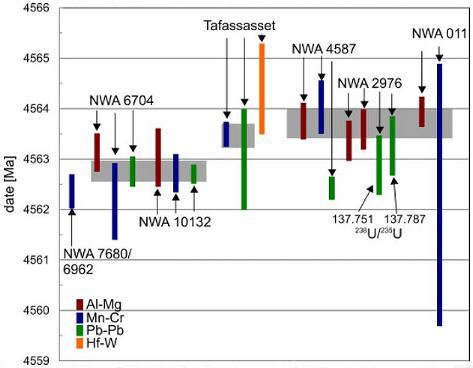
Diagram credit: Huyskens et al., 50th LPSC, #2736 (2019) The meteorites composing this unique pairing group were found to have features consistent with a low weathering grade described as generally unshocked (S1) after significant annealing (Warren et al., 2013). The specimen of NWA 6704 framed above is a 1.56 g fragment.






